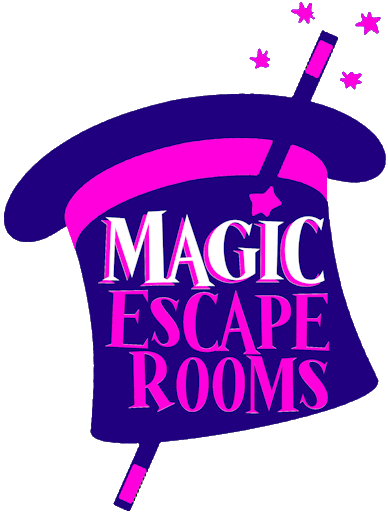The Art of Puzzle Flow
Crafting Engaging Puzzle Experiences in Escape Room Design
At Magic Escape Rooms in Columbus, Ohio, we often receive compliments from guests about some of our “never-before-seen puzzles,” how the puzzles were “incorporated differently into the game,” and how “the game is better” than most other room escapes they’ve played. There is a reason for this, and we’re about to share it.
Have you ever walked out of an escape room feeling exhilarated and satisfied, or perhaps frustrated and confused? A key factor determining this experience is the puzzle flow—the way puzzles are sequenced and connected to create a smooth, engaging, and logical progression.
At our escape room in downtown Columbus, we prioritize excellent puzzle flow within the escape room design to ensure our guests have a truly immersive and rewarding experience. This article explores the art of crafting effective puzzle flow in escape room design, revealing the secrets behind creating captivating and satisfying adventures.
What is Puzzle Flow? Why Does it Matter in Escape Room Design?
Puzzle flow refers to the logical and thematic progression of puzzles within an escape room. A well-designed flow ensures that:
Puzzles connect logically. Each solved puzzle naturally leads to the next, creating a sense of discovery and progression.
Difficulty is balanced. The difficulty curve gradually increases, providing a satisfying challenge without overwhelming players.
The narrative is supported. Puzzles contribute to the overall storyline and enhance the immersive experience.
Players remain engaged. A smooth flow prevents frustration and keeps players motivated to continue.
Poor puzzle flow, on the other hand, can lead to confusion, frustration, and a disjointed experience.
Key Elements of Good Puzzle Flow in Escape Room Design
Logical Sequencing: Puzzles should be sequenced in a way that makes sense within the narrative and the physical space. Solving one puzzle should provide the information or tools needed to solve the next. This creates a clear path for players to follow and enhances the escape room logic. The escape room is a story being told.
Thematic Consistency: Puzzles should be thematically consistent with the room's overall story and design. This creates a more immersive and believable experience. At Magic Escape Rooms, we ensure every puzzle fits seamlessly into the narrative of each room.
Variety of Puzzle Types: A good mix of puzzle types (logic puzzles, riddles, physical challenges, search tasks, etc.) keeps players engaged and caters to different skill sets. This provides a more well-rounded escape room experience.
Clear Clues and Feedback: Clues should be clear, concise, and logically connected to the puzzles they are meant to solve. Providing feedback when a puzzle is solved correctly reinforces progress and motivates players. Excessive “red-herrings” should always be a no-no. Our goal is not to make a game super difficult by frustrating players with illogical, and/or false, clues. This is important for positive player feedback.
Gradual Difficulty Curve: The difficulty of puzzles should gradually increase throughout the room. Starting with easier puzzles builds confidence and provides a foundation for tackling more complex challenges later on. This creates a satisfying puzzle difficulty curve.
Storytelling and Narrative Integration: Puzzles should not just be isolated challenges; they should contribute to the overall story and enhance the narrative. This creates a more immersive and engaging experience. This is key for compelling escape room storytelling.
Playtesting and Iteration: Thorough playtesting is essential for identifying any flaws in the puzzle flow and making necessary adjustments. We conduct playtesting at Magic Escape Rooms to ensure a smooth and enjoyable experience for our guests. In fact, continual game improvement, even after launch, is part of our escape room development process. We continue to learn what makes our games better.
Magic Escape Rooms Prioritizes Puzzle Flow for an Unforgettable Experience.
At Magic Escape Rooms Columbus, we understand the importance of puzzle flow in creating a truly exceptional escape room experience. Our experience with escape room builds has taught us to craft custom puzzles, considering its placement within the overall flow to ensure a fun, engaging, and rewarding adventure.
In Our Games, You Will Find We Prioritize…
Logical Connections - Every puzzle connects seamlessly to the next, creating a clear and satisfying progression.
Thematic Immersion - Puzzles are integrated into the room's theme, enhancing the narrative and creating a more believable experience.
Balanced Challenges - Our rooms offer a variety of puzzle types and a gradual difficulty curve to cater to different skill levels. We love players to have the ability to solve multiple puzzles at the same time without unnecessarily restricting them into solving just one puzzle at a time (aka “linear puzzle flow) unless we desire a specific sequence of how puzzles must be solved.
Experience the Art of Puzzle Flow: Book Your Escape Room Adventure Today!
Looking for engaging escape rooms in Columbus, Ohio? Visit Magic Escape Rooms and experience the difference that well-designed puzzle flow makes. Book Your Adventure Today!



